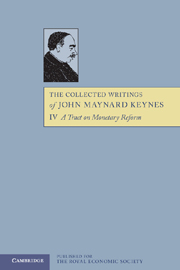Book contents
- Frontmatter
- Contents
- General Introduction
- Note to the reader
- Preface
- Preface to the French Edition
- 1 THE CONSEQUENCES TO SOCIETY OF CHANGES IN THE VALUE OF MONEY
- 2 PUBLIC FINANCE AND CHANGES IN THE VALUE OF MONEY
- 3 THE THEORY OF MONEY AND THE EXCHANGES
- 4 ALTERNATIVE AIMS IN MONETARY POLICY
- 5 POSITIVE SUGGESTIONS FOR THE FUTURE REGULATION OF MONEY
- Appendix I
- Appendix II
- Appendix III
- Index
5 - POSITIVE SUGGESTIONS FOR THE FUTURE REGULATION OF MONEY
Published online by Cambridge University Press: 05 November 2012
- Frontmatter
- Contents
- General Introduction
- Note to the reader
- Preface
- Preface to the French Edition
- 1 THE CONSEQUENCES TO SOCIETY OF CHANGES IN THE VALUE OF MONEY
- 2 PUBLIC FINANCE AND CHANGES IN THE VALUE OF MONEY
- 3 THE THEORY OF MONEY AND THE EXCHANGES
- 4 ALTERNATIVE AIMS IN MONETARY POLICY
- 5 POSITIVE SUGGESTIONS FOR THE FUTURE REGULATION OF MONEY
- Appendix I
- Appendix II
- Appendix III
- Index
Summary
A sound constructive scheme must provide—if it is to satisfy the arguments and the analysis of this book:
1. A method for regulating the supply of currency and credit with a view to maintaining, so far as possible, the stability of the internal price level; and
2. A method for regulating the supply of foreign exchange so as to avoid purely temporary fluctuations, caused by seasonal or other influences and not due to a lasting disturbance in the relation between the internal and the external price level.
I believe that in Great Britain the ideal system can be most nearly and most easily reached by an adaptation of the actual system which has grown up, half haphazard, since the war. After the general idea has been exhibited by an application in detail to the case of Great Britain, it will be sufficient to deal somewhat briefly with the modifications required in the case of other countries.
Great Britain
The system actually in operation to-day is broadly as follows:
(1) The internal price level is mainly determined by the amount of credit created by the banks, chiefly the Big Five; though in a depression, when the public are increasing their real balances, a greater amount of credit has to be created to support a given price level (in accordance with the theory explained above in chapter 3, p. 61) than is required in a boom, when real balances are being diminished.
- Type
- Chapter
- Information
- The Collected Writings of John Maynard Keynes , pp. 141 - 160Publisher: Royal Economic SocietyPrint publication year: 1978



